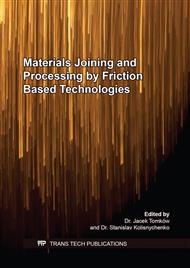[1]
H. REZAEI, M. H. MIRBEIK, H. BISADI. Effect of rotational speeds on microstructure and mechanical properties of friction stir-welded 7075-T6 aluminum alloy [J]. Mechanical engineering science, 2011, 225:1761-1773.
DOI: 10.1177/0954406211404633
Google Scholar
[2]
G.Q. Wang, Y.H. Zhao, Y.F. Hao. Friction stirs welding of high-strength aerospace aluminum alloy and application in rocket tank manufacturing [J]. Journal of Materials Science & Technology, 2018, 34:73–91.
DOI: 10.1016/j.jmst.2017.11.041
Google Scholar
[3]
S. D. Ji, Y. Y. Jin,Y. M. Yue, et al. Effect of Temperature on Material Transfer Behavior Different Stages of Friction Stir Welded 7075-T6 Aluminum Alloy [J]. J. Master. Sci. Technol, 2013, 29(10):955-960.
DOI: 10.1016/j.jmst.2013.05.018
Google Scholar
[4]
R. Nandan, T. DebRoy, H.K.D.H. Bhadeshia. Recent advances in friction-stir welding-Process, weldment structure and properties [J]. Progress in Materials Science, 2008, (53):980-1023.
DOI: 10.1016/j.pmatsci.2008.05.001
Google Scholar
[5]
G.K. Padhy, C.S. Wu, S. Gao. Friction stir based welding and processing technologies - processes, parameters, microstructures and applications: A review [J]. Journal of Materials Science & Technology, 2018, 34:1–38.
DOI: 10.1016/j.jmst.2017.11.029
Google Scholar
[6]
P.SIVARAJ, D.KANAGARAJAN. Fatigue crack growth behaviour of friction stir welded AA7075-T651 aluminium alloy joints [J]. Transactions of Nonferrous Metals Society of China, 2014, 24(08):2459-2467.
DOI: 10.1016/s1003-6326(14)63371-9
Google Scholar
[7]
P. VIJAYA KUMAR, G. M. REDDY, K. S. RAO. Microstructure and pitting corrosion of armor grade AA7075 aluminum alloy friction stir weld nugget zone -Effect of post weld heat treatment and addition of boron carbide [J]. Defence Technology, 2015, (11):166-173.
DOI: 10.1016/j.dt.2015.01.002
Google Scholar
[8]
S. M. Bayazid, H. Farhangi, H. Asgharzadeh, et al. Effect of cyclic solution treatment on microstructure and mechanical properties of friction stir welded 7075 Al alloy [J]. Materials Science & Engineering A, 2016, (649):293-300.
DOI: 10.1016/j.msea.2015.10.010
Google Scholar
[9]
Y. Q. Mao, L.M. Ke, Y. H. Chen, et al. Inhomogeneity of microstructure and mechanical properties in the nugget of friction stir welded thick 7075 aluminum alloy joints [J]. Journal of Materials Science & Technology, 2018, 34:228–236.
DOI: 10.1016/j.jmst.2017.11.039
Google Scholar
[10]
Xiangqian Liu, Huijie Liu, Tianhao Wang, et al. Correlation between microstructures and mechanical properties of high-speed friction stir welded aluminum hollow extrusions subjected to axial forces [J]. Journal of Materials Science & Technology, 2018, 34:102–111.
DOI: 10.1016/j.jmst.2017.11.015
Google Scholar
[11]
Z. Guo, H. Zhu, S. P. Cui, et al. FEM of temperature field and residual stress field in 7075 aluminum alloy FSW joint [J]. Transactions of the china welding institution, 2015, 36(2): 92-97.
Google Scholar
[12]
X. C. HE, F. S. GU, A. Ball. A review of numerical analysis of friction stir welding [J]. Progress in Materials Science, 2014, (65):1-66.
DOI: 10.1016/j.pmatsci.2014.03.003
Google Scholar
[13]
N. Yazdian, F. Karimzadeh, M. Tavoosi. Microstructural evolution of nanostructure 7075 aluminum alloy during isothermal annealing [J]. Journal of Alloys and Compounds, 2010, 493:137–141.
DOI: 10.1016/j.jallcom.2009.12.144
Google Scholar
[14]
R. Arabi Jeshvaghani, H.R. Shahverdi, S.M.M. Hadavi. Investigation of the age hardening and operative deformation mechanism of 7075 aluminum alloy under creep forming [J]. Materials Science and Engineering A, 2012, 552: 172-178.
DOI: 10.1016/j.msea.2012.05.027
Google Scholar
[15]
Y.C. Lin, Y. Q. Jiang, X. M. Chen, et al. Effect of creep-aging on precipitates of 7075 aluminum alloy [J]. Materials Science and Engineering A, 2013, 588:347–356.
DOI: 10.1016/j.msea.2013.09.045
Google Scholar
[16]
E. Cerri, P. Leo. Mechanical properties evolution during post-welding-heat treatments of double-lap Friction Stir Welded joints [J]. Materials & Design, 2011, (32):3465-3475.
DOI: 10.1016/j.matdes.2011.01.052
Google Scholar
[17]
F. C. Liu, Z. Y. Ma. Influence of tool dimension and welding parameters on microstructure and mechanical properties of friction-stir-welded 6061-T651 aluminum alloy [J]. Metall. Mater. Trans. A, 2008, 39(10):2378-2388.
DOI: 10.1007/s11661-008-9586-2
Google Scholar
[18]
X. C. LI. The microstructure and metallograph of aluminum alloy [M]. Beijing: Metallurgical Industry Press, 2010.7.
Google Scholar
[19]
H. G. ZHU, H. Z. WANG. The Research and Test Methods of Material Science [M]. Nanjing: Southeast University Press, (2008).
Google Scholar
[20]
T. S. RAO, G. M. REDDY, S. R. K. RAO. Microstructure and mechanical properties of friction stir welded AA7075-T651 aluminum alloy thick plates [J]. Transactions of Nonferrous Metals Society of China, 2015, (25):1770-1778.
DOI: 10.1016/s1003-6326(15)63782-7
Google Scholar
[21]
P. SIVARAJ, D. KANAGARAJAN, V. BALASUBRAM- ANIAN. Fatigue crack growth behaviour of friction stir welded AA7075-T651 aluminum alloy joints [J]. Transactions of Nonferrous Metals Society of China, 2014, (24):2459-2467.
DOI: 10.1016/s1003-6326(14)63371-9
Google Scholar
[22]
S. Yang. Thermo-mechanical Numerical Simulation of Friction Stir Welding [D]. Xi'an: XI' AN University of Architecture and Technology, (2007).
Google Scholar



